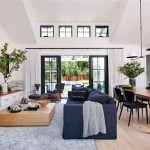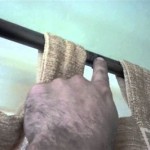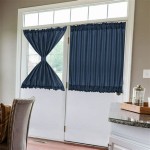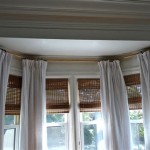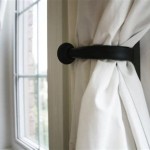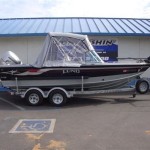Curtain Tracks For Bay Windows: A Comprehensive Guide
Bay windows, characterized by their projecting structure and multiple panes, offer a unique architectural feature adding light and space to a room. However, dressing these windows with curtains presents specific challenges compared to standard flat windows. Standard curtain rods often prove inadequate for the angles and curves inherent in bay window design. This is where specialized curtain tracks designed for bay windows become essential. They offer a flexible and aesthetically pleasing solution for hanging curtains, ensuring smooth operation and a professional finish.
Choosing the right curtain track for a bay window requires careful consideration of several factors, including the shape and angles of the window, the weight of the desired curtains, and the overall aesthetic of the room. A properly selected and installed track system not only enhances the functionality of the curtains but also complements the architectural beauty of the bay window itself. This article provides a detailed overview of curtain tracks specifically designed for bay windows, covering different types, materials, installation considerations, and factors that influence the selection process.
Understanding the Different Types of Bay Window Curtain Tracks
Curtain tracks for bay windows differ significantly from straight curtain rods due to their flexibility and ability to accommodate the angles and curves of the window structure. Several types of tracks are available, each with its own advantages and suitability for different bay window configurations. The primary types include flexible tracks, sectional tracks joined by connectors, and custom-bent tracks.
Flexible Tracks: These tracks are made from malleable materials like PVC or aluminum that can be bent by hand to fit the contours of the bay window. They are particularly well-suited for bay windows with gradual curves or slight angles. Flexible tracks are relatively easy to install and adjust, making them a popular choice for DIY projects. However, their load-bearing capacity is typically lower than that of rigid tracks, making them less suitable for heavy curtains.
Sectional Tracks with Connectors: This type of track consists of straight sections that are joined together using corner connectors. These connectors allow for precise angles, making them ideal for bay windows with sharp corners. The sections are typically made of aluminum or steel, offering greater strength and stability compared to flexible tracks. While sectional tracks provide a more structured appearance, the connectors can sometimes impede the smooth movement of the curtains if not properly aligned and installed.
Custom-Bent Tracks: These tracks are manufactured specifically to match the exact dimensions and angles of a particular bay window. Fabricated from durable materials like aluminum or steel, custom-bent tracks offer a seamless and professional finish. They are designed to ensure smooth and effortless curtain movement, even with heavy fabrics. While custom-bent tracks are the most expensive option, they provide the best fit and performance, particularly for complex bay window configurations.
Materials and Durability of Bay Window Curtain Tracks
The material of the curtain track significantly influences its durability, load-bearing capacity, and overall aesthetic. Common materials used for bay window curtain tracks include aluminum, steel, and PVC. Each material offers distinct advantages and disadvantages.
Aluminum: Aluminum tracks are lightweight, corrosion-resistant, and relatively easy to bend, making them a popular choice for both flexible and sectional tracks. Aluminum is strong enough to support medium-weight curtains and offers a sleek, modern appearance. It's a good balance between cost, durability, and ease of installation.
Steel: Steel tracks provide superior strength and durability, making them suitable for supporting heavy curtains, such as lined drapes or blackout curtains. Steel tracks are typically used in sectional or custom-bent configurations due to their rigidity. While steel tracks are more robust than aluminum tracks, they are also heavier and more expensive.
PVC: PVC tracks are primarily used for flexible tracks due to their high malleability. They are a cost-effective option for lightweight curtains and offer good resistance to moisture. However, PVC tracks are not as strong as aluminum or steel tracks and are more prone to sagging or bending under heavy loads. They are best suited for light and airy sheer curtains or lightweight decorative panels.
The choice of material should be based on the weight of the curtains that will be hung, the desired aesthetic, and the budget constraints. For heavy curtains, steel tracks are the preferred option, while aluminum tracks offer a good balance between strength and cost for medium-weight curtains. PVC tracks are suitable only for very lightweight curtains.
Installation Considerations for Bay Window Curtain Tracks
Installing curtain tracks for bay windows requires careful planning and attention to detail to ensure proper functionality and a professional appearance. The installation process varies depending on the type of track chosen, but certain fundamental principles apply to all installations.
Measurement and Planning: Accurate measurement is crucial for successful installation. Measure the length of each section of the bay window, including the angles at the corners. Use a protractor or angle finder to determine the exact angles of the corners. Create a detailed plan outlining the placement of the tracks and the location of any necessary brackets or connectors. For custom-bent tracks, provide the exact measurements and angles to the manufacturer during the ordering process.
Mounting Brackets: Select appropriate mounting brackets based on the type of track and the weight of the curtains. Brackets should be securely attached to the wall or ceiling using appropriate screws and anchors. Ensure that the brackets are spaced evenly along the track to provide adequate support. For heavy curtains, use more brackets to prevent sagging. Consider the projection of the brackets from the wall or ceiling to avoid interference with window frames or other architectural features.
Track Alignment: Proper alignment of the track sections is essential for smooth curtain movement. Use a level to ensure that the tracks are installed horizontally. When using sectional tracks with connectors, carefully align the sections to minimize any gaps or offsets. For flexible tracks, gently bend the track to match the contours of the bay window, avoiding any sharp bends that could impede the movement of the curtain carriers.
Curtain Carriers and End Stops: Install curtain carriers (also known as gliders or runners) onto the track before attaching the end stops. The number of carriers required depends on the weight and fullness of the curtains. End stops prevent the carriers from sliding off the track. Securely attach the end stops to both ends of the track.
Professional Installation: For complex bay window configurations or for those unfamiliar with DIY projects, professional installation is recommended. Professional installers have the expertise and tools necessary to ensure a precise and secure installation, guaranteeing smooth curtain operation and a flawless finish. They can also advise on the best type of track for specific needs and provide valuable insights on curtain selection and styling.
Factors Influencing the Selection of Bay Window Curtain Tracks
Choosing the optimal curtain track for a bay window involves considering a range of factors, including the window's shape, the intended curtain style, the desired level of light control, and the overall aesthetic of the room. Each of these factors plays a crucial role in determining the most suitable track system.
Shape and Configuration of the Bay Window: The shape and angles of the bay window significantly influence the choice of curtain track. For bay windows with gentle curves, flexible tracks are often the most convenient and aesthetically pleasing option. For windows with sharp corners, sectional tracks with connectors provide a more structured and precise fit. For intricate or unusually shaped bay windows, custom-bent tracks offer the best solution for a seamless and professional appearance.
Weight and Style of Curtains: The weight and style of the desired curtains are essential considerations. Heavy curtains, such as lined drapes or blackout curtains, require stronger and more durable tracks made from steel or heavy-duty aluminum. Lightweight curtains, such as sheer panels or voile curtains, can be supported by lighter tracks made from aluminum or PVC. The style of the curtains also influences the choice of track. For example, pinch-pleat curtains require specific types of carriers and may benefit from a more robust track system.
Light Control and Privacy Requirements: The desired level of light control and privacy influence the choice of curtain fabric and, consequently, the type of track. Blackout curtains, designed to block out all light, require a sturdy track system that can support their weight and prevent sagging. If privacy is a primary concern, consider using curtains with a tight weave or a heavy lining. The track should allow the curtains to be drawn fully across the window to provide complete coverage.
Aesthetic Considerations: The curtain track should complement the overall aesthetic of the room. Choose a track that blends seamlessly with the existing décor and architectural style. Tracks are available in various finishes, including brushed nickel, chrome, white, and black. Consider the visibility of the track. If you prefer a minimalist look, opt for a track that is concealed behind a valance or cornice. If the track is visible, choose a finish that complements the curtain hardware and other decorative elements in the room.
Budget Constraints: The budget available for the project is a practical consideration. Custom-bent tracks are the most expensive option, while flexible tracks are generally the most affordable. Sectional tracks offer a good compromise between cost and performance. Consider the long-term cost-effectiveness of the track. A slightly more expensive, higher-quality track may prove to be a better investment in the long run due to its increased durability and longevity.
By carefully considering these factors, homeowners can select the ideal curtain track system for their bay windows, ensuring both functionality and aesthetic appeal. A well-chosen and properly installed track system enhances the beauty of the bay window and provides years of reliable performance.

Ceiling Mounted Bay Window Curtain Track In Awkward

How To Choose The Perfect Bay Window Curtain Pole Ultimate Guide

Drapery Track For Bay Windows Curtain Tracks Com

Ceiling Mounted Bay Window Curtain Track In Awkward

How To Measure A Bay Window For Curtain Pole Or Track

Jim Lawrence Bay Window Curtain Poles

Your Essential Guide To Bay Window Curtain Poles Tracks Curtains Blinds Li

Curtain Tracks Rails Huge Range Fast Uk Delivery

Bay Window Curtain Tracks Rails Direct Fabrics

Wave Curtain Track For A Bay Window Custom Made T S

